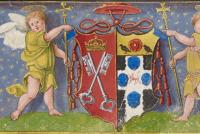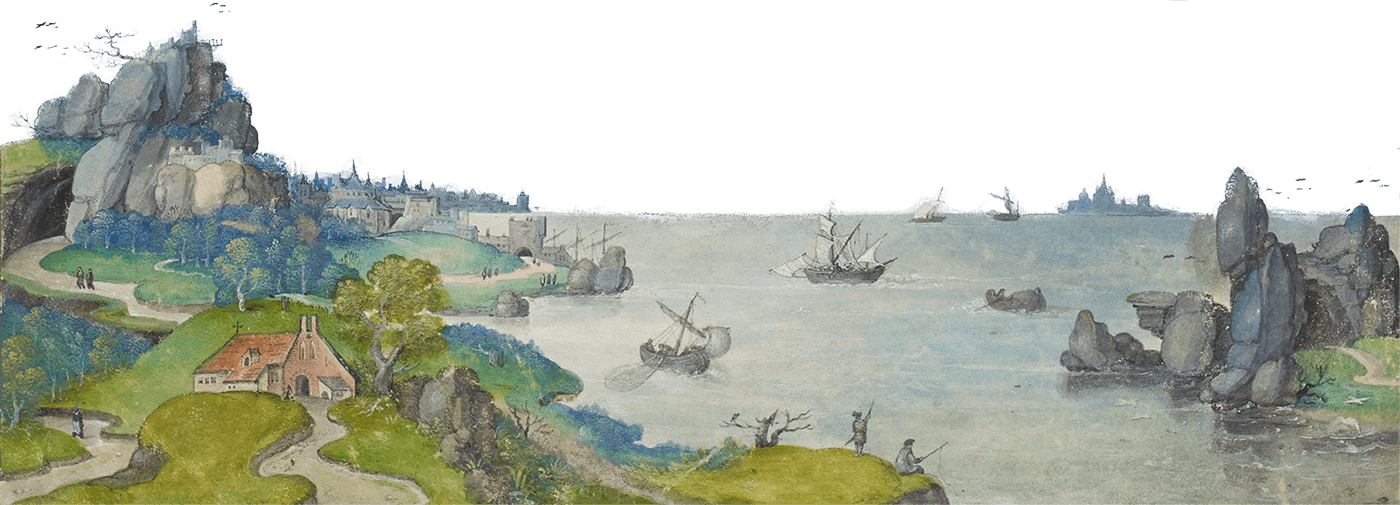Cardinal Wolsey’s Patronage of the Arts
Published on 11/05/2017 | Originally published 2005, draft for a CD-ROM
Thomas Wolsey was the greatest English art patron of his age. As England’s leading churchman and the king’s first minister – cardinal-legate and chancellor – he had both the motive and the opportunity. For contemporaries, magnificent buildings and fine objects proclaimed social rank, political power and greatness of mind; but inappropriate magnificence reeked of vainglory. Wolsey measured himself against the English nobility, whom he disciplined in the Court of Star Chamber and whom he expected to hold bowls and towels when he sang mass on grand occasions. For all his humble birth as the son of an Ipswich trader – a butcher, as his enemies frequently pointed out – his position demanded that he appear greater than the greatest peers. He must be greater, too, than the other English bishops, several of them, such as Richard Fox, Richard Fitzjames and William Warham, great builders or patrons of learning. His total income from church posts, royal offices and pensions from foreign rulers may have been five times that of the archbishop of Canterbury or the duke of Buckingham, his nearest rivals in either group, so he had the cash to turn power into possessions. Beyond England, he could feel himself the equal of the great cardinal-ministers of other European monarchs, famous builders of palaces and founders of colleges like Georges d’Amboise, Pedro González de Mendoza and Francisco Jiménez de Cisneros. His cardinal-legateship ultimately tied him to the papal court and the great patrons of the High Renaissance, the popes and cardinals who commissioned Michelangelo and Raphael.1
Wolsey saw clearly the agenda this set him as a patron and set to with the efficiency that had commended him to Henry VIII as the man who got his armies organised in his first war against France. In virtually every area of the visual arts, music and scholarship he exercised a patronage distinctive in its scale and impact and fashionable, if not advanced, in its attachment to continental trends. His educational projects, Cardinal’s College, Oxford and its fifteen feeder schools, led by his Ipswich College, were grander than anything in either English university, King’s College, Cambridge included. He stocked the Oxford college, twice as well-endowed as any other, with the best English and foreign scholars he could find, aiming to promote the new humanist learning as well as the best of the traditional curriculum. He encouraged the humanist medical scholar Thomas Linacre, promoted the performance of classical drama and owned a nine-sided portable sundial probably made by Nicolaus Kratzer, the German astronomer he appointed to lecture in Oxford.2 His houses, Hampton Court, York Place, The More, Tyttenhanger and Esher, were built by a works organisation larger than the king’s, and indeed Hampton Court and York Place, renamed Whitehall, became Henry VIII’s two main palaces once he had confiscated them from the cardinal. They were not very novel in design, though he does seem to have pioneered the construction of large guest lodgings with comfortable access from internal corridors and of free-standing long galleries, down which he and his guests could stroll to enjoy the surrounding gardens and water features.3
For the decoration of his houses and colleges Wolsey called on the best craftsmen of his day. The Netherlanders Barnard Flower and James Nicholson supplied him with top-quality stained glass, both heraldic glass for his halls, chambers and closets and religious scenes for his chapels, based on designs by Dürer and his followers. The Florentine sculptor Giovanni da Maiano gave a renaissance flourish to the conventional exterior of Hampton Court with terracotta roundels of Roman emperors, while others added classical pilasters on the long gallery and friezes of playful putti in the cardinal’s private rooms. His gold and silver plate, massive in weight but finely decorated in the latest ‘antique’ styles with putti, scallop shells and so on, came from Robert Amadas, the king’s leading goldsmith, when it was not a gift from the king of France or a special order from the luxury goldsmiths of Bruges. His seals and the illuminations he commissioned for documents and books associated with his colleges featured elements of classical design probably introduced by Flemish artists. He bought fine paintings from Antwerp, though little detail of them survives. By buying up other churchmen’s holdings as they came on the market and placing direct orders with the manufacturers in the Low Countries, Wolsey assembled the largest tapestry collection in England: more than six hundred pieces strong and including subjects sacred, historical, chivalrous and mythological.4 And his lasting fame was entrusted to another Florentine, Benedetto da Rovezzano, charged with building him a tomb deliberately grander than Henry VII’s, in the latest Italian style with angel-topped gilt-bronze pillars nearly four metres tall, saints, putti, griffins, a gilt-bronze effigy of the cardinal and a black marble sarcophagus subsequently re-used for Admiral Lord Nelson.
How expert Wolsey’s patronage really was is at this distance hard to say, but there are signs that he thought hard about his commissions. The master-masons at his Ipswich college brought him the building plans ‘to know his pleasure therein’ and Thomas Cromwell reported back to him on the ‘largeness, beauty, sumptuous, curious and substantial building’ at Oxford.5 He personally auditioned four singing boys for the Ipswich college choir. During an interview on a tricky political subject at York Place, Thomas More supposedly distracted him by the gambit ‘I like this gallery of yours, my Lorde, muche better then your gallerie at Hampton Court’.6 Another time, it was said, he went to admire the work under way on his tomb, only for his fool to warn him prophetically that for all the money he was spending on it he would end with a pauper’s burial.7 Like the fool, contemporaries were less concerned with the degree of Wolsey’s connoisseurship than with the state of his pride. His magnificence was readily satirised or taken as evidence of fortune’s propensity to raise men to greatness and then cast them down.
The range and scale of Wolsey’s ventures was a gift to his critics. In Collyn Clout and Why come ye nat to Court? the poet-priest John Skelton railed not only at the cardinal’s power-mad grip on government, church and foreign affairs and at his reprobate lifestyle, but also at his buildings with their turrets, towers, halls and bowers and his tapestries of the Triumphs of Petrarch, a wholly unsuitable riot of ‘Dame Dyana naked’, ‘lusty Venus’ with Cupid shooting his bow at her ‘tyrly tyrlowe’, elephants, unicorns, and ‘Naked boyes strydynge, / With wanton wenches wynkyng’.8 The Italian historian and papal official Polydore Vergil, imprisoned by Wolsey, claimed his overweening building plans were spoilt by his ineptitude in choosing sites and that his colleges were ‘intended to enhance his own empty glory rather than serve the interests of religion and scholarship’.9 The Protestant exiles William Roy and Jerome Barlow denounced his ‘grett palaces with out compareson … / More lyke unto a paradice / Than an erthely habitacion’.10
Of course, reaction to Wolsey’s works was never wholly negative. Those who wished to praise him stressed not only his wisdom in justice, diplomacy and social policy but also his patronage of learning. Those who saw him as an exemplar of fickle fortune asked what had become of his ‘buyldyngs somptious’ made by ‘Expertest artificers that ware both farre and nere’, his ‘galleries … both large and long’ or his tomb, ‘Wrought of fine copper, that cost many a pound’.11 In his life of Wolsey, his servant George Cavendish lovingly recalled the cardinal’s plate, vestments, clothes, music, tapestries, colleges, houses and entertainments: together they testified to the ‘great welthe, joy, tryhumphe and glory’ he had enjoyed before his humbling.12 Whatever one thought of Wolsey, the greatness of his works could not be denied. Today, all too many of them have been lost. But what survives, from Hampton Court to Christ Church, from his sundial to his manuscripts, speaks to us of the magnificence that he sought and that, judging from the reaction of his contemporaries, he resoundingly achieved.
1. Except where otherwise indicated, information in this chapter is taken from the chapters by Roger Bowers, Philippa Glanville, Steven Gunn, Phillip Lindley, John Newman, Simon Thurley and Hilary Wayment in Cardinal Wolsey; Church, State and Art, ed. S.J. Gunn and P.G. Lindley (Cambridge, 1991). Back to text
2. Henry VIII: a European court in England, ed. D.R. Starkey (London, 1991), pp. 71-2. Back to text
3. S. Thurley, Hampton Court: a social and architectural history (New Haven and London, 2003), pp. 15-41. Back to text
4. T. Campbell, ‘Cardinal Wolsey’s tapestry collection’, The Antiquaries Journal, 76 (1996), 73-137. Back to text
5. LP, IV, ii. 4135, 5077. Back to text
6. N. Harpsfield, The Life and Death of Sir Thomas More, knight, sometymes Lord High Chancellor of England, ed. E.V. Hitchcock (Early English Text Society 186, 1932), p. 33. Back to text
7. Chronicle of King Henry VIII of England, ed. M.A.S. Hume (London, 1889), p. 29. Back to text
8. John Skelton, The Complete English Poems, ed. J. Scattergood (Harmondsworth, 1983), p. 270. Back to text
9. The Anglica Historia of Polydore Vergil AD 1485-1537, ed. D. Hay (Camden Society 3rd series 74, 1950), pp. 225, 317. Back to text
10. Rede me and be nott wrothe, for I saye no thinge but trothe, ed. E. Arber (London, 1871), p. 57. Back to text
11. G. Cavendish, ‘Metrical Visions’ in The Life of Cardinal Wolsey, ed. S.W. Singer (London, 1827 edn), pp. 532, 536-7. Back to text
12. G. Cavendish, The Life and Death of Cardinal Wolsey, ed. R.S. Sylvester (Early English Text Society 243, 1959), pp. 19-20, 23-8, 67-74, 98-9, 123. Back to text




